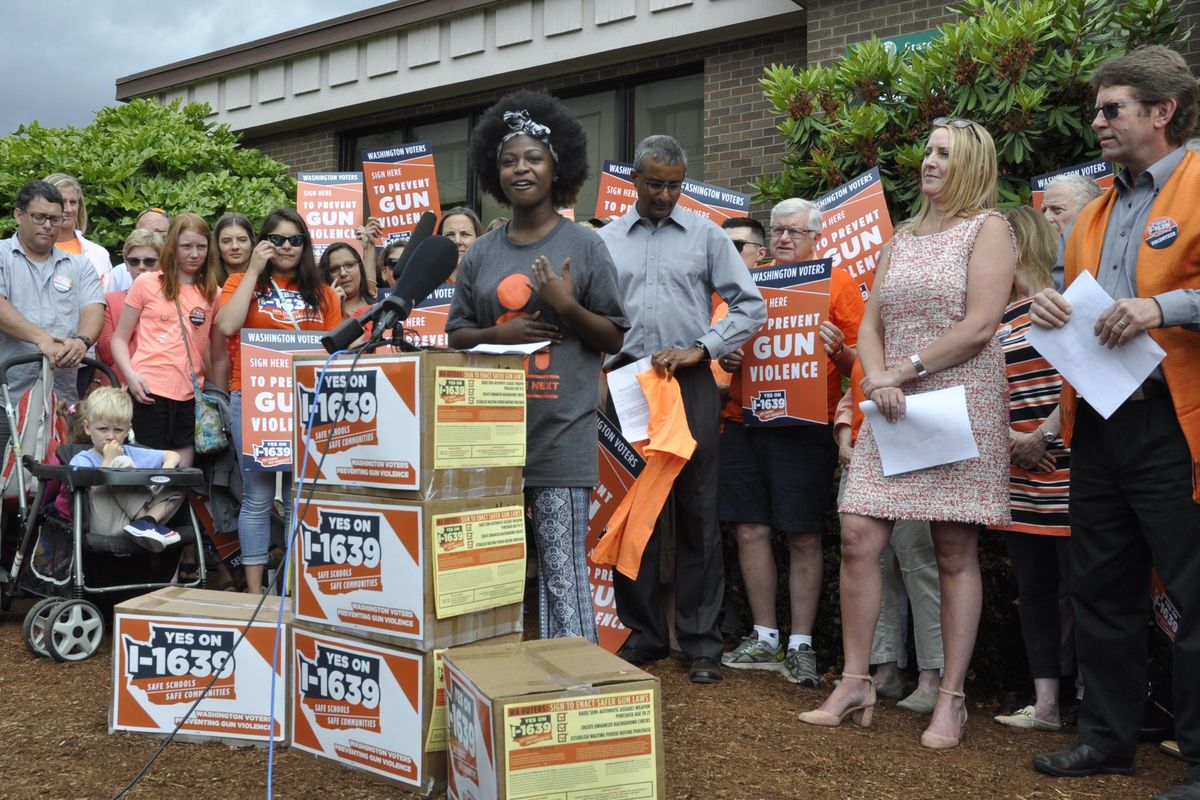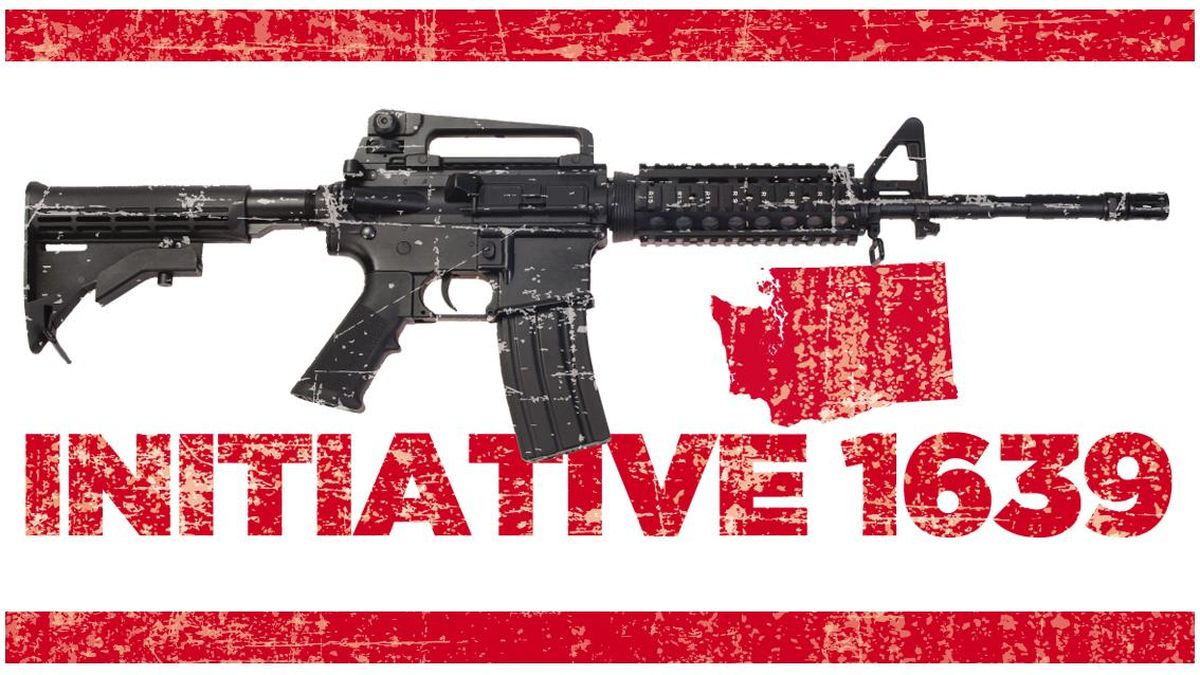With court fight over, gun control measure goes around Legislature to voters
OLYMPIA – Ola Jackson, a Rainier Beach High School student, addresses other volunteers for the Initiative 1639 campaign before turning in signatures for the gun control ballot measure on July 6. (Jim Camden / The Spokesman-Review)
For about a week, it looked like Washington wouldn’t vote this year on a sweeping gun control initiative that would restrict the sale of semi-automatic rifles and require firearms to be stored safely in the home.
But neither supporters nor opponents of Initiative 1639 took a break between a Thurston County Superior Court judge’s ruling the measure could not go on the November ballot and a Washington Supreme Court ruling that it must. Both had campaigns in full swing as soon as the high court said questions about the size of type and formatting in the initiative language weren’t enough to kill it.
“We’ve always been planning to run a full campaign,” said Tallman Trask, a spokesman for the Alliance for Gun Responsibility. “We still had a full field operation working.”
Phil Watson, campaign manager for Save Our Security No on I-1639, one of two opposition campaigns, said fundraising was a bit more difficult while the status of the initiative was up in the air.
“It’s really tough to get support for or against any initiative until people know it’s going to be on the ballot for sure,” Watson said. But the court decision was final just before Labor Day and “that’s when people start getting serious about it.”
I-1639 has several elements that those who support gun control and those who support gun rights have been debating for years.
It would put new restrictions on the sale of semi-automatic rifles, raising the age of purchase from 18 to 21 and requiring more extensive background checks, so buying one of those rifles would have the same limitations as buying a handgun in Washington state.
It would also require gun owners to keep their firearms in locked storage or otherwise secured in the home when not in use, making them criminally liable if someone obtains their unlocked gun and uses it in a crime or an accident.
The Legislature has tried, and failed, to ban or restrict the sales of military-style semi-automatic rifles and pass some type of safe-storage law. Proposed legislation usually generates passionate testimony from both sides in packed hearing rooms, but the bills rarely get a floor vote. With thin majorities in both chambers, gun-rights advocates can usually count on one or two Democrats to vote with Republicans to block those bills.
An effort to put similar restrictions on the sales of what were listed as semi-automatic tactical weapons died in the closing days of the 2018 Legislature. I-1639 was filed slightly more than a month later.
Along with the age restrictions, it requires a buyer to provide proof of completing a firearm training program within the last five years which includes instruction on basic safety rules, secure gun storage, talking to children about guns and preventing suicide with firearms. The state Department of Licensing would keep a copy of the applications to purchase or transfer a rifle, and allow gun dealers to charge a $25 fee for the background checks and paperwork.
While the text refers repeatedly to “semiautomatic assault rifle” – and supporters routinely use the term in campaign materials – the definition in I-1639 covers any rifle that allows a round to be fired by pulling the trigger after the previous round has been fired. It excludes rifles that require bolt, lever or pump action between rounds, antiques, and those that are inoperable.
Opponents point out that covers practically all semi-automatic rifles, from small caliber rifles used for target shooting to those that resemble military weapons and have been used in some mass shootings.
In the past, legislation has tried to limit the restrictions to particular features the rifles have, like pistol grips, folding stocks or large capacity magazines. The broader language in I-1639 is an attempt to address the complaints that gun-rights groups and firearms manufacturers have had that previous legislation was picking on cosmetic features of the rifle.
“What we’re talking about here is the specific deadliness,” Trask said, the ability to fire many rounds quickly.
Alan Gottlieb, chairman of the Citizens Committee to Keep and Bear Arms, said he expects opponents to focus on what he calls “criminalizing self-defense” through the safe-storage requirements. He uses the example of a woman who has a valid concealed weapon permit and carries a handgun in her purse for self-defense. If she comes into her home, sets her purse down on the counter and doesn’t lock it up, she could be arrested for committing a crime, he said.
Trask counters that’s a misreading of the initiative. A person can only be charged with community endangerment, a felony, if the gun isn’t safely stored and a child or some someone who’s not allowed to possess a firearm takes it and hurts or kills someone or uses it in a crime.
Twenty-seven states have some type of law requiring safe storage of firearms, Trask said.
But the Giffords Law Center to Prevent Gun Violence indicates most of those are restrictions designed to prevent access to guns by minors. Only 11 require some sort of locking device on some or all firearms in a home, and only Massachusetts requires all firearms to be stored in a locked container or with a tamper-resistance safety device, similar to what I-1639 would require.
Opponents may also try to score points with the argument that I-1639 amounts to age discrimination for those between 18 and 21, who are old enough to vote, sign a contract, marry and serve in the military, but won’t be able to purchase a semi-automatic rifle.
“It’s not equal protection under the law,” Gottlieb said.
But the law already restricts handgun purchases to those 21 and older, Trask said, and there’s been no successful legal challenge of that.
Based on the most recent reports with the Public Disclosure Commission, the I-1639 campaign had raised more than $4.4 million, with about $1.2 million from Microsoft co-founder Paul Allen, $1.2 million from venture capitalist Nick Hanauer and his wife, Leslie, and $1 million from former Microsoft CEO Steve Ballmer and his wife, Connie.
But with expenses of more than $3.78 million to pay people to gather signatures and the campaign, plus consultants, polling and staff salaries, the Safe Schools Safe Communities had already spent $4 million by its last expense report in mid-August. And that was before all the legal bills were in for arguing the case before the courts.
Washingtonians and the National Rifle Association for Freedom, by comparison, has raised about $159,000, with $150,000 coming from NRA headquarters in Fairfax, Virginia. Although most of its expenses have been for printing of ads and bumperstickers, and website design, it did pay out more than $35,000 in August for the lawsuit it joined trying to block the initiative from the ballot.
By comparison, Save Our Security No on I-1639, has raised about $16,500 in cash contributions, much of it going for consulting work from a Wyoming company called Bulletproof Communications. Watson said he’s been active in gun rights in Washington for years and formerly worked for the Second Amendment Foundation, and will be running a “grassroots campaign.” He also knows all the local NRA representatives who will be working for the other opposition campaign.
“We’ll coordinate as much as we legally can,” Watson said.
If I-1639 passes, that probably won’t end of the legal battles. Having failed on challenges over alleged problems with the language on the back of the petitions that were signed, opponents would likely try to keep it off the books with a new challenge centered around the requirement that an initiative deal with only one subject.
They could argue the initiative deals with gun sales and storage plus licensing and fees. Supporters are likely to counter that the single subject is semi-automatic firearms.

